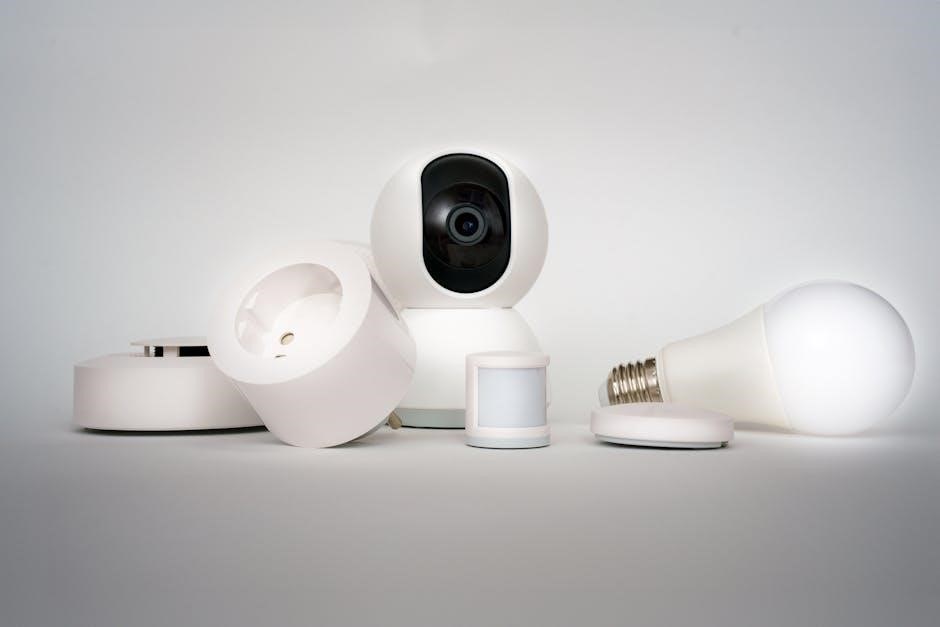Smoke detector installation is crucial for home safety, providing early warning in case of fires. This guide offers a comprehensive overview of the process, including placement and types of detectors to ensure optimal protection.
Importance of Smoke Detectors in Home Safety
Smoke detectors play a critical role in safeguarding lives and property by providing early warnings of potential fires. According to fire safety statistics, homes equipped with functioning smoke detectors experience a 50% reduction in fire-related deaths and injuries. These devices detect smoke particles in the air, triggering alarms that allow occupants to evacuate promptly, minimizing exposure to toxic fumes and flames; Moreover, smoke detectors prevent extensive property damage by alerting residents before fires escalate. They are a cornerstone of home safety systems, ensuring compliance with fire codes and insurance requirements. Regular maintenance, including sensor cleaning and battery checks, is essential to guarantee reliability. By installing and maintaining smoke detectors, homeowners can significantly enhance their safety and peace of mind.

Choosing the Right Smoke Detector

Selecting the appropriate smoke detector involves considering detection accuracy, smart connectivity, and battery options to ensure reliable fire safety tailored to your home’s specific needs.

Types of Smoke Detectors: Ionization vs. Photoelectric
Smoke detectors are primarily categorized into ionization and photoelectric types. Ionization detectors use a small radioactive source to detect smoke particles, excelling at identifying fast-flaming fires. Photoelectric detectors, on the other hand, rely on light scattering to detect larger smoke particles, making them more effective for smoldering fires. Both types provide essential fire detection capabilities, but their performance varies based on fire conditions. Ionization detectors are often more prone to false alarms near kitchens or bathrooms, while photoelectric detectors are generally quieter and more suitable for areas with cooking fumes. Understanding these differences helps homeowners choose the most appropriate detector for their safety needs.
Features to Consider: Smart Connectivity and Battery Options
Modern smoke detectors offer advanced features like smart connectivity, enabling remote monitoring and alerts through smartphone apps. This feature ensures timely notifications, even when you’re not home. Additionally, voice assistant integration allows seamless control and status checks. Battery options vary, with hardwired detectors relying on your home’s electrical system, while others use replaceable or sealed 10-year batteries. Some models combine both power sources for reliability. Consider detectors with battery backup to maintain function during power outages. Smart features and reliable battery options enhance safety and convenience, ensuring your smoke detectors remain functional and alert you to potential dangers without unnecessary disruptions or maintenance hassles.
Planning the Installation
Assess your home’s layout to determine the number of detectors needed. Identify optimal locations and ensure compliance with NFPA guidelines for spacing and placement.
Optimal Placement of Smoke Detectors
Proper placement of smoke detectors is critical for ensuring early detection of fires. Install detectors on every level of your home, including basements and attics, and inside or near sleeping areas. Place them on ceilings or walls, at least 10 feet away from cooking appliances to minimize false alarms. Avoid areas near bathrooms, windows, or ceiling fans, as drafts may reduce effectiveness. For hallways, install detectors 10-15 feet apart, and in large rooms, ensure coverage by following NFPA spacing guidelines. Test detectors monthly and replace batteries annually to maintain reliability. Proper placement ensures comprehensive protection and adherence to safety standards.
Understanding NFPA Guidelines for Detector Spacing
The National Fire Protection Association (NFPA) provides clear guidelines for smoke detector spacing to ensure effective fire detection. Smoke detectors should be installed no more than 30 feet apart in areas with smooth ceilings and no more than 25 feet apart in areas with sloped or beamed ceilings. Detectors should also be placed at least 10 feet away from cooking appliances to reduce false alarms. Additionally, detectors must be within 21 feet of any wall and spaced evenly throughout the home. These guidelines ensure comprehensive coverage and reliable detection, adhering to safety standards for optimal protection. Proper spacing is essential for maximizing the effectiveness of smoke detectors in emergencies.

Pre-Installation Steps
Gather tools like screwdrivers and drills, and ensure the installation site is clean and free from debris. Check the manufacturer’s instructions for specific requirements.

Gathering Necessary Tools and Materials

Before starting the installation, ensure you have all the required tools and materials. A Phillips Head screwdriver and drill with appropriate bits are essential for mounting. Additionally, gather the smoke detector unit, its mounting plate, and any screws or anchors provided. If hardwiring, ensure you have the correct wiring materials. For battery-powered detectors, install a fresh 9V alkaline battery. Refer to the manufacturer’s manual for specific requirements. Keep the base station ready for smart detectors. Avoid placing detectors near bathrooms or kitchens to minimize false alarms. Having all components ready ensures a smooth and efficient installation process. Proper preparation prevents delays and ensures safety.
Preparing the Installation Site
Before installing a smoke detector, ensure the site is clean and free from dust or debris. Identify the optimal location, typically on the ceiling or high on a wall, away from vents and direct sunlight. Avoid areas near bathrooms, kitchens, or ceiling fans to reduce false alarms. Check for any obstructions, such as ceiling beams or windows, that might interfere with detector placement. Ensure the surface is level and secure for proper mounting; If installing on a wall, maintain a minimum distance of 10 feet from bathrooms to comply with NFPA guidelines. Proper site preparation ensures the detector functions accurately and adheres to safety standards.

The Installation Process
Mount the smoke detector base securely on the ceiling or wall, ensuring it is level. Attach the detector to the base, following the manufacturer’s instructions for proper alignment and tightening. Use a screwdriver to secure the base and ensure the detector is firmly in place. Proper installation ensures optimal functionality and reliability of the smoke detection system, providing critical early warnings in case of emergencies.
Mounting the Smoke Detector Base
Mounting the smoke detector base is the first critical step in the installation process. Locate the optimal position on the ceiling or wall, ensuring compliance with NFPA guidelines. Use a screwdriver to mark the wall or ceiling where the screws will go, ensuring the base is level. Drill pilot holes if necessary, then secure the base using the provided screws or anchors. Make sure the base is tightly fastened to prevent any movement. For ceiling installations, avoid areas near ceiling fans or vents to minimize false alarms. Properly aligning and securing the base ensures the detector functions correctly and provides reliable fire safety protection. Follow the manufacturer’s instructions for specific mounting requirements.
Attaching the Smoke Detector to the Base
Once the base is securely mounted, align the smoke detector with the base by matching the arrows or notches on the detector and the base. Gently twist the detector clockwise until it clicks into place, ensuring a secure connection. Make sure the detector is firmly attached and level. Some models may require batteries to be installed before attaching the detector to the base. After securing the detector, test it by pressing the test button to ensure it emits a loud, clear alarm sound. This step confirms proper installation and functionality. Refer to the manufacturer’s guide for specific instructions, as some models may have additional features or requirements for attachment.
Post-Installation Testing

After installation, press the test button to ensure the smoke detector emits a clear, loud alarm. Verify proper functionality and interconnectivity with other units if applicable.
Testing the Smoke Detector’s Functionality
Testing the smoke detector’s functionality is essential to ensure it works correctly. Press the test button to verify a clear, loud alarm sound. Use a test spray or canned smoke to simulate conditions. Check for proper interconnectivity if multiple detectors are linked. Ensure no false alarms occur during testing. Clean the detector monthly to avoid debris buildup. Refer to the manufacturer’s manual for specific testing instructions. Regular testing helps maintain reliability and ensures early fire detection. NFPA guidelines recommend testing smoke detectors monthly and replacing them every 10 years. Proper testing ensures your home remains protected and the system functions as intended during emergencies.